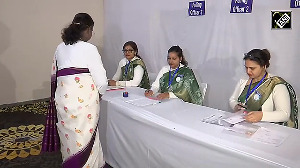In the first three months of the 2007 calendar year (for which the latest data is available), exports of textiles to the US went up by 7.5 per cent in terms of quantity over the same period of 2006. But in value terms, India's textile exports fell by half a per cent. China is no longer a comparable example for India because it is in a different league as far as textile exports are concerned. But for the record, China too took a major hit in its unit value realisation, but unlike India maintained overall growth -- exports in terms of quantity went up by 46 per cent while in value terms, they grew by 25 per cent.
But take a look at how India's other major competitors in the textiles sector fared in this period. Bangladesh, Indonesia and Vietnam -- all of them notched up much higher growth in value terms (16 to 21 per cent) than in terms of quantity (5 to 17 per cent) establishing that they increased their margins on exports. Note that all these countries had seen a depreciation of their currency against the dollar -- ranging from 0.25 per cent to 2.3 per cent between April 2006 and March 2007. In comparison, the Indian rupee appreciated against the dollar by 4.45 per cent in the same period. If you think of why the Chinese also took a hit on their margins, the reason could well be that their currency also appreciated by 3.4 per cent in this period.
The appreciating rupee may just be one of the reasons why the Indian textiles sector may have suffered in the exports market. The industry has already realised that it has to absorb the impact of currency exchange fluctuations and instead look for compensatory measures from other sources. For instance, there are issues pertaining to labour market rigidities and non-reimbursement of local and state-level taxes, which are hurting exports particularly of garments, where the decline in unit value realisation has been even steeper. In the case of garments, India's exports to the US in Jan-March 2007 went up by 4 per cent in terms of quantity, but fell by more than 2 per cent in value terms.
Over 35 million people are employed in this sector. The textiles ministry can ill afford to ignore the industry's problems if they deteriorate further, resulting in job losses. The industry has made a fervent plea for a refund of the local and state-level taxes levied on its exports. The finance ministry may argue that it would be difficult to quantify the extent of this burden. But the industry has come back with a neat formula. The additional customs duty levied on imports at 4 per cent is justified on account of the local and state-level duties imposed on domestically manufactured goods. So, why not simply refund textile exporters 4 per cent of their costs? Even the World Trade Organisation cannot find fault with this relief.
But the move has not made much headway. The textiles ministry has as many as nine export promotion councils entrusted with the responsibility of taking care of exports of different textile items like apparels, cotton textiles, handicrafts, handloom products, wool and woolens, silk products, synthetic and rayon textiles, powerloom fabrics and carpets. But falling unit value realisation from the exports of textiles has not yet motivated the ministry or the councils into any concrete action so far. The IT and IT-enabled services sector does not have even one export promotion council devoted to its needs. Its exports were estimated at about $32 billion in 2006-07.
The commerce ministry has 12 more export promotion councils ostensibly taking care of export requirements of industries such as engineering, project exports, basic chemicals, pharmaceuticals, cosmetics, leather, sports goods, gems and jewelry, shellac, forest products, cashew and plastics. There is an export promotion council even for export-oriented units and those in special economic zones.
Exports need a quick diagnosis of their problems and quick solutions. Markets once lost take many years before they can be regained. Export promotion councils may have helped create a few jobs, but their contribution to boosting exports is debatable.







 © 2025
© 2025